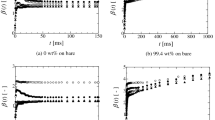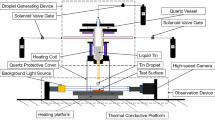Abstract
Droplet impact and equilibrium contact angle have been extensively studied. However, solidification contact angle, which is the final contact angle formed by molten droplets impacting on cold surfaces, has never been a study focus. The formation of this type of contact angle was investigated by experimentally studying the deposition of micro-size droplets (∼39 μm in diameter) of molten wax ink on cold solid surfaces. Scanning Electron Microscope (SEM) was used to visualize dots formed by droplets impacted under various impact conditions, and parameters varied included droplet initial temperature, substrate temperature, flight distance of droplet, and type of substrate surface. It was found that the solidification contact angle was not single-valued for given droplet and substrate materials and substrate temperature, but was strongly dependent on the impact history of droplet. The angle decreased with increasing substrate and droplet temperatures. Smaller angles were formed on the surface with high wettability, and this wetting effect increased with increasing substrate temperature. Applying oil lubricant to solid surfaces could change solidification contact angle by affecting the local fluid dynamics near the contact line of spreading droplets. Assuming final shape as hemispheres did not give correct data of contact angles, since the final shape of deposited droplets significantly differs from a hemispherical shape.











Similar content being viewed by others
Abbreviations
- C p :
-
Specific heat of droplet
- D :
-
Diameter of spherical droplet
- G :
-
Shear modulus of substrate
- h :
-
Height of sessile droplet
- H :
-
Elastic displacement of viton surface
- k 0 :
-
Thermal conductivity of substrate
- k c :
-
Thermal conductivity of substrate coating
- k d :
-
Thermal conductivity of droplet
- l :
-
Thickness of substrate coating
- L :
-
Flight distance of droplet
- L f :
-
Latent heat of fusion of droplet
- R c :
-
Thermal resistance of substrate coating
- R d :
-
Thermal resistance of droplet
- t :
-
Time
- t solid :
-
Solidification time scale of droplet
- t spr :
-
Spreading time scale of droplet
- T d :
-
Droplet temperature upon impact
- T j :
-
Jetting temperature
- T m :
-
Droplet melting temperature
- T s :
-
Substrate temperature
- U :
-
Velocity of droplet upon impact
- X :
-
Thickness of solidified layer
- α0 :
-
Thermal diffusivity of substrate
- αd :
-
Thermal diffusivity of droplet
- θc :
-
Calculated contact angle of sessile droplet
- θe :
-
Equilibrium contact angle
- θl :
-
Contact angle measured on the left of photographs
- θr :
-
Contact angle measured on the right of photographs
- θs :
-
Solidification contact angle
- λ:
-
Parameter defined in Eq. 7
- μ:
-
Viscosity of droplet
- ρ:
-
Density of droplet
- σ:
-
Surface tension of droplet
- Ca:
-
μ U/σ (Capillary number)
- Pr:
-
μ C p /k d (Prandtl number)
- Re:
-
ρ UD/μ (Reynolds number)
- Ste:
-
C p (T m−T s)/L f (Stefan number)
- We:
-
ρ U 2 D/σ (Weber number)
- β:
-
(T d−T m)/(T m−T s) (Superheat parameter)
References
Pasandideh-Fard M, Pershin V, Chandra S, Mostaghimi J (2002) J Therm Spray Technol 11(2):206
Mostaghimi J, Pasandideh-Fard M, Chandra S (2002) Plasma Chem Plasma Process 22(1):59
Attinger D, Zhao Z, Poulikakos D (2000) ASME J Heat Transfer 122:544
Hayes DJ, Wallace DB (1998) Chip Scale Rev 2(4):75
Waldvogel JM, Diversiev G, Poulikakos D, Megaridis CM, Attinger D, Xiong B, Wallace DB (1998) ASME J Heat Transfer 120:539
Gao F, Sonin AA (1994) Proc R Soc Lond A 44:533
Snyder T, Korol S (1999) In: IS&T’s Recent progress in Ink Jet Technologies II. In Hanson E (ed) Springfield, VA, pp 175–181
Chandra S, Avedisian CT (1991) Proc R Soc Lond A 432:13
Bennett T, Poulikakos D (1993) J Mater Sci 28:963; Doi: 10.1007/BF00400880
Zhao Z, Poulikakos D, Fukai J (1996) Int J Heat Mass Transfer 39(13):2791
Waldvogel JM, Poulikakos D (1997) Int J Heat Mass Transfer 40(2):295
Aziz SD, Chandra S (2000) J Heat Mass Transfer 43:2841
Haferl S, Poulikakos D (2002) J Appl Phys 92(3):1675
Fukai J, Shiiba Y, Yamamoto T, Miyatake O (1995) Phys Fluids 7(2):236
Sikalo S, Tropea C, Ganic EN (2002) Exp Therm Fluid Sci 29:795
Sikalo S, Wilhelm H–D, Roisman IV, Jakirlic S, Tropea C (2005) Phys Fluids 17:062103
Schiaffino S, Sonin AA (1997) Phys Fluids 9(8):2217
Hoffman RL (1975) J Colloid Interface Sci 50:228
Schiaffino S, Sonin AA (1997) Phys Fluids 9(11):3172
Bhola R, Chandra S (1999) J Mater Sci 34:4883
Kim H-Y, Chun J-H (2001) Phys Fluids 13(3):643
Carslaw HS, Jaeger JC (1959) In: Conduction of heat in solids. 2nd edn, Clarendon Press, Oxford, pp 288–289
Gong S-C (2005) Jpn J Appl Phys 44(5A):3323
Amada A, Haruyama M, Ohyagi T, Tomoyasu K (2001) Surf Coat Tech 138:211
Haferl S, Poulikakos D (2003) Int J Heat Mass Transfer 46:535
Carre A, Gastel J-C, Shanahan MER (1996) Nature 379:432
Acknowledgements
The authors greatly thank Dr. Stephan Drappel from Xerox Research Centre of Canada for his help and discussion. The authors are indebted to Chris Wagner and Bradley Gerner from Xerox Corporation for their assistance in setting up the jetting fixture and to David Gervasi from Xerox Corporation for the viton coating. This work is supported by Xerox Foundation and Natural Sciences and Engineering Research Council of Canada (NSERC).
Author information
Authors and Affiliations
Corresponding author
Rights and permissions
About this article
Cite this article
Li, R., Ashgriz, N., Chandra, S. et al. Solidification contact angles of molten droplets deposited on solid surfaces. J Mater Sci 42, 9511–9523 (2007). https://doi.org/10.1007/s10853-007-1757-9
Received:
Accepted:
Published:
Issue Date:
DOI: https://doi.org/10.1007/s10853-007-1757-9




